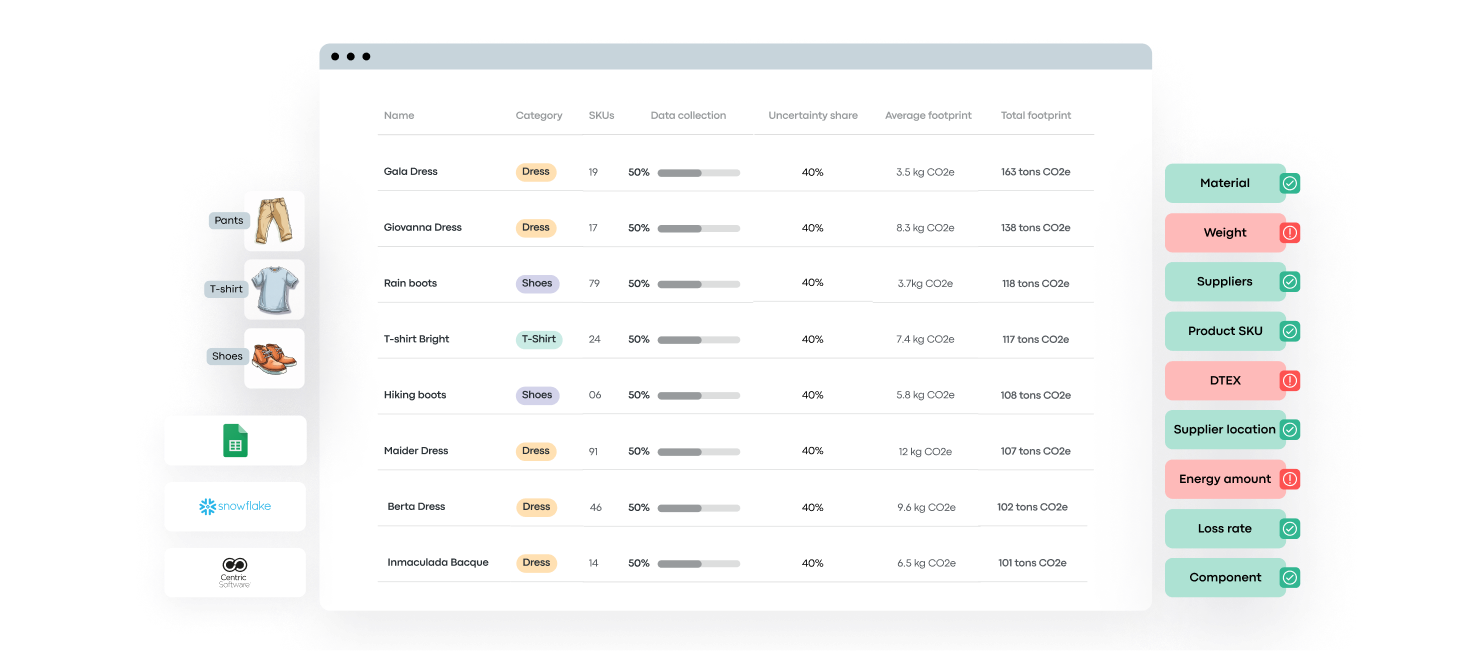Sustainability reporting software
for apparel and footwear brands
Automate your environmental reporting. Measure once, report everywhere.












Selected by 150+ fashion, luxury and footwear brands










Built for fashion
Focused exclusively on apparel and footwear, our granular supply chain knowledge enables us to deliver the most accurate results and act as an extension of your sustainability team.
No manual work
Carbonfact’s AI does the heavy lifting when it comes to centralizing your diverse data sets. We identify gaps and anomalies and fill in the missing details such as weights and dtex.
Accurate
Thanks to our product-centric approach, we don't rely on spend-based information when calculating your emissions, making our results most accurate and future-proof with the upcoming regulations.
How Carbonfact works
Our journey begins by ingesting all your existing product and supply chain data. We consolidate and clean your diverse data sets, from any source, in any format. To reduce your workload to a minimum, we build a custom connector that integrates with your existing systems, automating future data import and creating a live connection to Carbonfact.

Incomplete data? Not a problem - we identify and fill in your data gaps. Data engineering features and AI - trained on extensive primary data sets - automatically fill in missing details like component weights, dtex, and process-level steps.

Once your data is processed, our Life Cycle Assessment engine automatically calculates the footprints for each of your products on an SKU level. The numbers update whenever new purchase orders are synced via the live data connection.

Carbonfact helps you identify emission hotspots and smartly prioritize your supplier data collection. By providing you with a concrete list of data points to gather from your suppliers, we save your team weeks of time and effort.

Explore your data with interactive dashboards, perform your yearly GHG Carbon Accounting, and automatically generate reports to stay compliant with CSRD and other regulatory requirements.

Dive into your data with our analytics dashboards and simulate changes using our advanced simulation tools. Model changes across components, materials, process steps, and transport on a product and catalog level.







Product footprint
Environmental impact measurement (LCA) for all your products on a process-step level, even with incomplete data.
Disclosure
Measure and report your emissions to stay compliant with EU and U.S. regulations such as CSRD, DPP, and the NY Fashion Act.
Auditable reports
Automatically format your data for your yearly climate reporting, aligning with multiple frameworks, such as the ESRS or ISSB.
Data provision
Carbonfact cleans and centralizes all, fills data gaps and helps you gather the necessary supply chain data for your climate reporting.
Insights
Easy-to-understand tables and graphs that update whenever new purchase orders are synced via the live connection.
Carbon accounting
Automate your Carbon Accounting (GHG Protocol standard) with high accuracy for Scope 3 emissions.
Simulation tools
Model product- and catalog-level changes in your supply chain, and build your decarbonization roadmaps as required by the CSRD.
Multi-indicators
Environmental score based on the 16 European PEFCR or the French Climate and Resilience law indicators for all your products on SKU level.
"With an increasing number of regulations, we heavily rely on Carbonfact to supply us with reliable data for disclosure purposes. We are fully aware of the risks of greenwashing and Carbonfact proves to be an invaluable tool in ensuring that the data we share is reliable. What truly impresses us about Carbonfact is its solid, science-based methodology combined with its fashion-oriented approach, which makes us feel that they are experts in our field."

Eve Morel
ESG Compliance Officer at Adore Me
Cobalt’s goal is to proactively manage our carbon footprint in the supply chain with the partners concerned and integrate such data into our ERP system. Carbonfact has enabled us to manage processes and the reporting of our emissions, as well as to ensure we comply with government regulations in both the production countries and importing countries.

Ellen Arosio
Senior Compliance and Sustainability Manager
at Cobalt Fashion
"Allbirds was founded to create better things in a better way, a mission that inspired our laser-focus on carbon reduction -- and eventually, labeling each of our products with its carbon footprint. As we continue to grow, Carbonfact's offerings, particularly its product-level focus for footwear and apparel, ensures we can both measure our carbon footprint and actively find ways to reduce it. Carbonfact has been instrumental in helping us model different scenarios and make informed decisions that align with our sustainability goals."

Aileen Lerch
Sustainability at Allbirds
"Among the crowded market of carbon management tools, Carbonfact stood out for us. Their solution met our specific needs of automating carbon footprint calculations for all our products and emission scopes in the textile industry. Carbonfact's LCA expertise, smart approach to handling data gaps, and ability to connect and feed calculation results back into our systems were key factors that convinced us.”

Katya Kruk
Impact & Innovation Director at ARMEDANGELS
"We have moved from spend-based carbon accounting into Carbonfact to prioritise primary data and get more accurate calculations. The main reason for us to choose Carbonfact is that we now not only get our company's total carbon footprint but also break it down for each of our products. Thanks to Carbonfact’s focus on the apparel industry we get life cycle assessments with industry specific data for all our products in an easy way. Which helps us make the right decisions and reach our goal of reducing our emissions by 50% before 2030.”

Malin Bosaeus
Global Sustainability Manager
at Happy Socks
“With the help of Carbonfact's production scenario simulator, we were able to assess the environmental impact of our supply chain and make an informed decision to move part of our manufacturing from China to Vietnam. This change has resulted in a 12% reduction in the carbon footprint of our upcoming January 2024 spring collection. “

Nicolas Gand
VP Production at Adore Me
Integrations
Our automated data ingestion feature imports and syncs data from any source, in any format, eliminating the need for manual entry and minimizing data-entry errors. Whether your data is stored in a database like a PLM or ERP system, a data warehouse like Snowflake or Google BigQuery, or even an Excel file, we’ve got you covered.


Inside the SEC Climate Disclosure Ruling for Footwear & Apparel Brands
Breakdown of SEC Climate Disclosure and what it could mean for your ...
 Lidia Lüttin
Lidia Lüttin

What California’s Climate Laws: SB 253 and SB 261 mean for fashion brands
Cumulatively, these new regulations are set to impact more than 10,0...
 Lidia Lüttin
Lidia Lüttin
![[Textile industry] CSDDD - Understanding the Corporate Sustainability Due Diligence Directive for Apparel & Footwear Brands](https://www.carbonfact.com/hs-fs/hubfs/Regulations%20%283%29-1.png?width=600&name=Regulations%20%283%29-1.png)
[Textile industry] CSDDD - Understanding the Corporate Sustainability Due Diligence Directive for Apparel & Footwear Brands
Learn about your obligations under the CSDDD.
![[Textile industry] CSDDD - Understanding the Corporate Sustainability Due Diligence Directive for Apparel & Footwear Brands](https://www.carbonfact.com/hubfs/lidia%20scwared.jpeg) Lidia Lüttin
Lidia Lüttin
What data is needed for the LCA engine to compute footprints?
Carbonfact requires specific data points related to your products to compute environmental footprints. This can include product taxonomy, weight, material composition, supplier information, and more. The data can be shared through static files like Excel or via a live connection to your data warehouse, PLM, or FTP server.
How can I provide new data to Carbonfact?
You can provide data through a live connection to a database, or by providing static exports like Excel files. A live connection is preferred for real-time insights.
What's the process for setting up a live data connection?
Setting up a live connection may begin with sharing static files. The optimal setup includes providing access to tables in your database like PLM, ERP, or data warehouses like Snowflake or Google BigQuery. Carbonfact can build a dedicated connector to your data.
What if I don't have all the required data?
It's okay if you don't have everything at first. Carbonfact will do its best to fill in the gaps and provide analytics to help you prioritize your data collection process.
How does Carbonfact handle data normalization and organization?
Carbonfact builds a dedicated connector to your data and uses normalization logic, heuristic rules, and machine learning to organize your data according to the internal data model called the Carbonverse.
How does Carbonfact communicate with customers?
Carbonfact typically communicates through a main point of contact and identifies key stakeholders across various teams. A shared Slack channel is used for meeting notes, action items, and questions.
What are the main stages of the customer journey with Carbonfact?
The customer journey with Carbonfact is broken down into three main stages: Collect, Measure, and Reduce. These stages involve connecting to your systems, measuring carbon footprint at the product level, and simulating alternative materials, suppliers and components to reduce carbon emissions.
How does the Reduce phase help to lower carbon emissions?
The Reduce phase helps you model and simulate product-level changes to your overall carbon trajectory. Starting from Week 10, you can work on reduction strategies and simulations, using tools that allow you to run what-if scenarios and visualize the carbon impact of changes to materials and components.
What does the onboarding process involve?
Our personalized onboarding process involves a dedicated team of data scientists and engineers working closely with your tech, data, production, and sustainability teams to consolidate and collect all available primary data. We also clean, parse, and build a custom connector to all your systems.
What professional services do you provide for reducing environmental impact?
We assist in identifying opportunities to reduce your impact and support building your decarbonization strategy and SBTi trajectory. Our services include corporate- and product-level strategy design, compliance advisory, SBTi support, carbon accounting, ESG reporting, data quality checks, and premium support with regular alignment meetings.
How do you ensure compliance and prevent greenwashing?
We provide advisory services to guide your communications campaigns, helping you stay compliant with existing and upcoming regulations and policies, and preventing greenwashing.